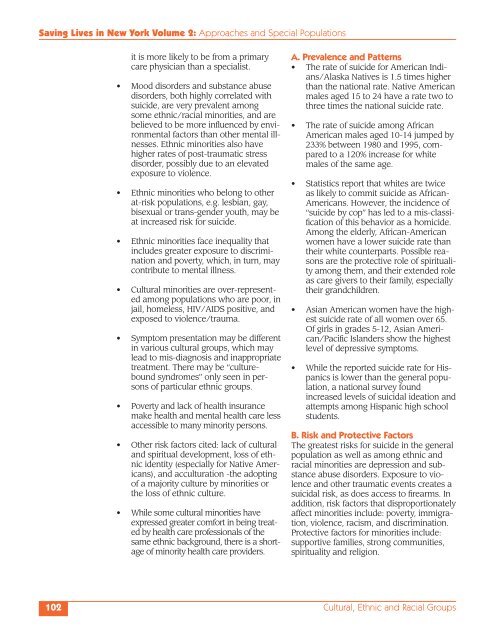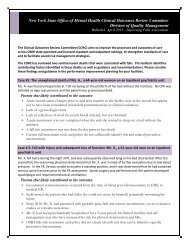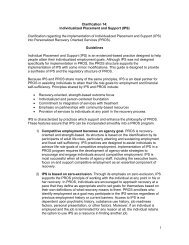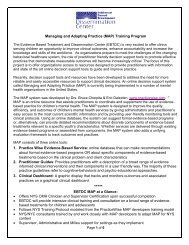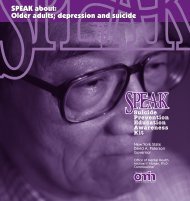Download - New York State Office of Mental Health
Download - New York State Office of Mental Health
Download - New York State Office of Mental Health
You also want an ePaper? Increase the reach of your titles
YUMPU automatically turns print PDFs into web optimized ePapers that Google loves.
Saving Lives in <strong>New</strong> <strong>York</strong> Volume 2: Approaches and Special Populations<br />
it is more likely to be from a primary<br />
care physician than a specialist.<br />
• Mood disorders and substance abuse<br />
disorders, both highly correlated with<br />
suicide, are very prevalent among<br />
some ethnic/racial minorities, and are<br />
believed to be more influenced by environmental<br />
factors than other mental illnesses.<br />
Ethnic minorities also have<br />
higher rates <strong>of</strong> post-traumatic stress<br />
disorder, possibly due to an elevated<br />
exposure to violence.<br />
• Ethnic minorities who belong to other<br />
at-risk populations, e.g. lesbian, gay,<br />
bisexual or trans-gender youth, may be<br />
at increased risk for suicide.<br />
• Ethnic minorities face inequality that<br />
includes greater exposure to discrimination<br />
and poverty, which, in turn, may<br />
contribute to mental illness.<br />
• Cultural minorities are over-represented<br />
among populations who are poor, in<br />
jail, homeless, HIV/AIDS positive, and<br />
exposed to violence/trauma.<br />
• Symptom presentation may be different<br />
in various cultural groups, which may<br />
lead to mis-diagnosis and inappropriate<br />
treatment. There may be “culturebound<br />
syndromes” only seen in persons<br />
<strong>of</strong> particular ethnic groups.<br />
• Poverty and lack <strong>of</strong> health insurance<br />
make health and mental health care less<br />
accessible to many minority persons.<br />
• Other risk factors cited: lack <strong>of</strong> cultural<br />
and spiritual development, loss <strong>of</strong> ethnic<br />
identity (especially for Native Americans),<br />
and acculturation -the adopting<br />
<strong>of</strong> a majority culture by minorities or<br />
the loss <strong>of</strong> ethnic culture.<br />
• While some cultural minorities have<br />
expressed greater comfort in being treated<br />
by health care pr<strong>of</strong>essionals <strong>of</strong> the<br />
same ethnic background, there is a shortage<br />
<strong>of</strong> minority health care providers.<br />
A. Prevalence and Patterns<br />
• The rate <strong>of</strong> suicide for American Indians/Alaska<br />
Natives is 1.5 times higher<br />
than the national rate. Native American<br />
males aged 15 to 24 have a rate two to<br />
three times the national suicide rate.<br />
• The rate <strong>of</strong> suicide among African<br />
American males aged 10-14 jumped by<br />
233% between 1980 and 1995, compared<br />
to a 120% increase for white<br />
males <strong>of</strong> the same age.<br />
• Statistics report that whites are twice<br />
as likely to commit suicide as African-<br />
Americans. However, the incidence <strong>of</strong><br />
“suicide by cop” has led to a mis-classification<br />
<strong>of</strong> this behavior as a homicide.<br />
Among the elderly, African-American<br />
women have a lower suicide rate than<br />
their white counterparts. Possible reasons<br />
are the protective role <strong>of</strong> spirituality<br />
among them, and their extended role<br />
as care givers to their family, especially<br />
their grandchildren.<br />
• Asian American women have the highest<br />
suicide rate <strong>of</strong> all women over 65.<br />
Of girls in grades 5-12, Asian American/Pacific<br />
Islanders show the highest<br />
level <strong>of</strong> depressive symptoms.<br />
• While the reported suicide rate for Hispanics<br />
is lower than the general population,<br />
a national survey found<br />
increased levels <strong>of</strong> suicidal ideation and<br />
attempts among Hispanic high school<br />
students.<br />
B. Risk and Protective Factors<br />
The greatest risks for suicide in the general<br />
population as well as among ethnic and<br />
racial minorities are depression and substance<br />
abuse disorders. Exposure to violence<br />
and other traumatic events creates a<br />
suicidal risk, as does access to firearms. In<br />
addition, risk factors that disproportionately<br />
affect minorities include: poverty, immigration,<br />
violence, racism, and discrimination.<br />
Protective factors for minorities include:<br />
supportive families, strong communities,<br />
spirituality and religion.<br />
102 Cultural, Ethnic and Racial Groups


